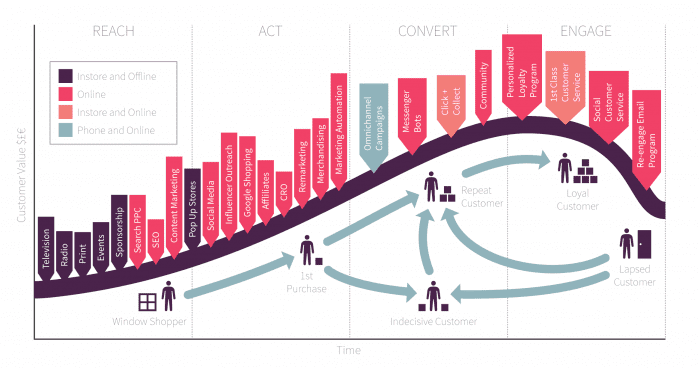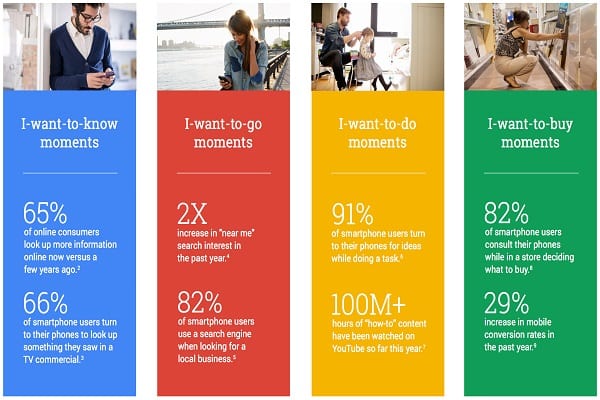The most important trends and innovations across the customer lifecycle to inform your 2018 ecommerce strategy using the RACE planning framework
Knowing the key techniques to improve your conversion rates is vital to any ecommerce marketing strategy. We will be taking a look at the biggest trends in ecommerce marketing you should seriously think about adopting in 2018 to get ahead of your competition.
We have created a series posts on digital marketing trends 2018 across marketing channels including, email, social, search engine marketing, and an overall 100+ must-see marketing research 2017 statistics. Now, we will evaluate the biggest innovations and strategies that should be adopted in the ecommerce sector.

Smart Insights customer lifecycle model for retail and ecommerce, details the different customer touchpoints across the RACE framework for different 'type of customers: window shoppers, 1st purchase, repeat customers, and loyal customer and what techniques can be used to re-engage lapsed customers.
Download Premium Member resource – Ecommerce trends 2018
Covers 16 trends across the customer lifecycle which are important to stay competitive.
Access the
REACH
Trend 1. Paid media (AdWords and social)
Although social media falls under 'act' it is important to use social media, as with any paid media, to reach your audience where they are. In a recent ecommerce benchmarks report by MarketingSherpa, they found that under half (43%) of companies with online stores report seeing significant traffic from social media.
Having a defined paid social strategy to promote your products or services, is vital to raising brand awareness, but integrating this with shoppable ad features on social platforms like Instagram and Snapchat can convince your target audience to 'act' and click through to your product landing page - from there it's up to your web design, sales copy, and user experience to convince them to convert.
Social media engagement over time has increased to 2 hours and 15 minutes, with 28% of 16-64 yr olds saying they use social media to research / find products to buy.
The term 'pay-to-play' has been tossed about recently with the increase in paid media opportunities available for brands on social media. Once a great platform to organically reach audiences worldwide, you need to start paying for sponsored posts to achieve even the basic audience targeting and out-shine your competitors.

Although many SEO, email and strategy marketers rule out social media as a platform that converts customers, it's a great place to start. Not advertising on social media is lost opportunity when your potential audience is trying to find a product similar to yours. The rise in beauty social bloggers and vloggers, mean for the beauty industry, users will be watching reviews and searching for social influencer opinions. Having a strategically placed ad pre or in the middle of the video your audience is watching is a great way to 'plant the seed' of your product in their minds.
Advanced retargeting through tracking cookies and personalization will help achieve a fully integrated ecommerce strategy that gives the user what they want, where they are.
Adwords
Within AdWords, over the past several years we have seen a mobile-first strategy in play where Google was seeking to protect its ad revenue as more users adopted smartphones. Initially enhanced campaigns were deployed and more recently, a range of ad extensions and bid adjustments have been released to give advertisers the flexibility to serve their ads, in the correct context depending on the device, user location and previous interactions via different online placements.
At Google I/O this year, Google CEO Sundar Pichai announced an “important shift from a mobile-first to an AI-first world” at Google. This is reflected in the main trends in [AdWords updates we have seen through 2017] which we can expect to continue into 2018. We categorize these changes as:
- Increased Machine Learning AI options in AdWords. For some time now Google has sought to use analysis of historical ad data to better inform decisions. Sometimes these changes have been to support less sophisticated advertisers, for example optimizing based on ‘Smart Goals’ or ‘Smart Bidding’ where the advertiser hasn’t set up their own business goals or complete their own bid adjustments. In other cases, the power of Machine Learning can be used on large scale campaigns to improve ROI, for example travel search site Trivago used Smart Display campaigns (which optimized targeting, bidding and over 25,000 ads on the display network).
- Revised and new extensions. In 2017 Google’s Shopping extension which is critical to retailers has been revised. Linking to real-world local retail outlets through the ‘affiliate location extension’ has also been released in 3 countries so will roll out to other markets in 2018.
- Improved experience and insight. AdWords practitioners will have seen the recent revised user interface. Improved insights such as the ‘average time to convert’ report are aimed at helping advertisers understand how their ad programmes fit with consumer behaviour which is often complex, involving multiple interactions and devices through time. The Mobile Landing page report helps here also. More support for testing through Campaign Experiments supports marketers to ‘test and learn’. Finally, the launch by Google of its new attribution tool in 2018 deserves special mention.
- Customized text ads. There are new options for creating text ads with customized text in it. You can now create text ads that update automatically with the information that you want your potential customers to know. Read more here.
- Test campaigns. Drafts and experiments help you optimize your search and Display Network campaigns, by letting you propose and test changes. There is detailed information available on testing campaigns, through Google Adwords Help, to help support marketers in the ‘test and learn’ process.
- Remarketing lists for search ads (RSLA). RSLA has proven to be an effective feature for Google Adwords.
ACT
"On demand" Commerce
Up until recently, customers had to sometimes accept slow deliveries or simply go to a shop if they wanted something quickly – but ecommerce has caught up. Today and in the future, getting items at speed, in real-time, will be more practical.
A few years back, the likes of the UK brand, Just Eat, made it possible to avoid phoning a takeaway to place an order and also making card payments possible for takeaway food shops. Local takeaways have battled it out to get the best reviews, by cooking great food and delivering it as fast as possible. Now, there is a whole new level of demand. Described as the latest biggest investment trend, on-demand is all about giving customers what they want, when they want it. Food, consumer goods and online content such as TV programs and films are all taking advantage of the desire of wanting something in an instant.
CONVERT
Micro-moment marketing
In today’s fast-paced, technology-oriented world, consumers are overwhelmed with content. Be it through ads, offers, emails, texts, social media and everything else, the industry has reached a point of “content shock where consumers cannot consume much more content than they already are”. Hence, the way brands devise their digital marketing strategy, to capture their audience’s attention, needs to change. Brands need to focus on the micro-moments of their customers’ behaviours.

ENGAGE
Customer Loyalty and retention
For Jet.com, sales soared over Black Friday and Cyber Monday promotional periods and mobile engagement is on the up, but they face a challenge of increasing customer retention. They may need to focus on loyalty programmes.
Hotels.com have a brilliant retention program, their rewards programme has various levels including the prestigious Gold reward level which offers discounts and “secret prices” as well as flash sales, on top of the existing programme. The programme allows customers to collect one free hotel night (average value is based on orders) when they purchase 10 nights via hotels.com, it’s favoured over hotel points loyalty programmes such as Starwood Preferred Guest, as customers realize that points don’t always mean prizes (at least not very quickly anyway). Take Avios for example, it takes a lot of spending to get the required points to get discounted and free flights. But after every 10 hotel stays a hotel room is all yours with hotels.com.
Research by Nielsen has found that shoppers in Finland and the UK have the most loyalty cards, but customers in the UK are least likely to use them. Over 9 in 10 (94%) of shoppers in Finland have loyalty cards and just under 9 in 10 (89%) of shoppers in the UK have them, but just half (51%) of shoppers in the UK use them.
Customer retention is important. Encouraging customers to purchase again is far easier, quicker and cheaper than attracting new customers. A focus on quality service always helps, IKEA keep their customers up to date with their delivery, an experience customers will remember.
Now hear what our expert contributors have to say about the future of ecommerce. We asked them "What do you think will be next big thing that will shape the future of ecommerce in 2018" and here are their answers...
Expert prediction

Erik Huberman, Keynote speaker and Founder and CEO of Hawke Media
Erik Huberman has built three successful ecommerce companies and is now Founder and CEO of Hawke Media, an outsourced CMO and Marketing Team which started in 2014 and has become the fastest growing marketing consultancy in the country with 120 full-time employees and valued at over 60 million dollars.
"In 2018, ecommerce advertising is going to continue to increase in expense and becoming a media platform is going to be much more critical. Brands that find ways to continue to engage their audience outside of just purchase points will start to gain ground because those who don't will find the expense of bringing people back too great to compete."

Paul Sullivan, Founder and Head of Marketing - PSMarketing
Focused on data-driven business development, he is a specialist in Inbound Marketing, Conversion Rate Optimisation, and Content.
"As trends go in marketing, retail generally is on the ball when it comes to customer acquisition and retention. They typically use Paid Search and Social Media to great effect and are continually optimising the online experience.
Looking to 2018 I think Artificial Intelligence will come into play in a big way, especially focused on the personalisation of the customer experience. Brands are already invested heavily in customer experience, but a number of artificial intelligence platforms have launched and are launching will drive that forward exponentially. Machine learning is definitely the place I see brands investing to ensure that they know as much as possible about the consumer to aid the sale and improve customer service."

Mark Hall, eCommerce Strategist & Author | Voice of Customer (VOC) Insights Expert
"2018 will be an exciting time for eCommerce marketing. Customers have awesome devices (i.e. smartphones) in their hands, and marketers have a lot of wide set of marketing technology available. The key in 2018 will be bringing these two things together in order to both make shopping more efficient and your virtual cash register ring more often.
In terms of time-saving, behind-the-screen technology, nothing holds more promise for 2018 than artificial intelligence (AI). During the past few years users have spent way too much time tapping and swiping their devices in heads-down mode. With the advent of AI algorithms from operating system providers and app builders these high-touch interactions simply aren’t always necessary. Users can ‘request it and forget it’ - that is, either verbalize a query or enter it via an old-fashioned Web form - then just wait a few minutes, or perhaps even a few hours, to see the optimal answer. Increasing use of these intelligent agents will mean people will spend much less time completing common, iterative tasks, and more time interacting in the real world.
On the MarTech side, 2018 will also see more investment in concierge-like features like optimized online chat and product finders. By optimized I don’t just mean ‘added as a link in the site header’; I mean fully humanized experiences that recognize and respect the user’s browsing history, use support agents well trained in empathy and solution selling, and that appear at just the right time and place in the experience. Yes, you always want more visitors to self-serve their way to purchases, but, given that, in my experience, human-assisted sessions have conversion rates three to ten times those of non-assisted ones, your investment in competent human agents will be well worthwhile.
Finally, personalized experiences will no longer be optional, but essential in 2018. Your visitor session data already gives you a valuable ‘footprint’ of what each of your visitors wants, and where they’ve been looking, or searching, to find it. To get higher conversions, and to leave a better brand impression, you’ve got to use this data to adjust the experience, ideally within the current session, but at a minimum between sessions. Focus returning visitor experiences on what’s most relevant by doing things like showing shopped categories more prominently, making recently-used filters larger, and pre-selecting size selections.
Follow these trends and you’ll see your average order value (AOV) and revenue per visitor (RPV), your golden marketing metrics, grow in 2018 and beyond. And you’ll surely see a high return on both your human and MarTech investment."

Sam Mallikarjunan, Executive Strategist - HubSpot
"My initial reflex with "cool" answers -- machine learning, AR/VR, etc. -- will likely only have secondary impacts on most eCommerce businesses. We can expect Amazon and their ilk to continue to invest in these technologies and they'll certainly have an impact on the tools that consumers use to engage with eCommerce brands such as search engines and social media apps. But the big thing will be the increasing sophistication of customer retention methodologies and tools. The only practical way for most eCommerce companies to remain competitive will be in creating an acquisition to lifetime value balance in their unit economics that gives them the leverage required to invest in marketing earlier in the buying cycle and other more advanced customer acquisition. If you're good at keeping customers you can spend more to get customers, and keeping customers has to evolve beyond spamming our email lists three times a week with a coupon."

Valentin Radu, CEO - Omniconvert
"As the behemoth of eCommerce, Amazon is already generating almost half of the total online retail from the US, the midsize players must become customer-centric.
2018 will be the year when data-driven decisions will become a must for eCommerce companies to thrive.
The CMO will not be a non-technical spending manager anymore. He will need to join forces with the CIO, CTO and CXO to act synergically and build an experience that will generate long-term relations with the customers. They will be more aware than ever that focusing on the lifetime value is vital for future growth and will orchestrate everything around an outstanding customer experience.
Customer-centricity, machine learning, and long-term relationships. Future growth versus short-term benefits. Customers versus products. Data versus feelings."

James Gurd - Ecommerce, Digital Transformation and Digital Strategy Consultant, Digital Juggler
"Exit intent is pretty much ubiquitous; we’ve all seen annoying pop-ups interrupting our browsing journey (my favourite – an overlay suggesting I subscribe to the newsletter on the confirmation page for my newsletter unsubscription!).
But exit intent is much maligned, and when executed properly can be a conversion lifesaver for ecommerce retailers.The evolution for exit intent marketing is to micro target user behaviour, rather than a macro campaign focused at page-level exits. Let me explain the difference:
Macro targeting - If anyone with a product in their shopping basket attempts to exit the website from the basket or checkout, you display an exit intent banner reminding them of their basket (with or without an incentive to purchase immediately).
Micro targeting - GA analysis reveals that product X is one of the biggest volume exit pages for products. The typical path to purchase involves at least 3 sessions and paid search and affiliate visitors are price sensitive i.e. conversion rate is significantly higher during promotions. An exit intent campaign is set-up to trigger when a user exits from the product page directly, only if they’ve visited the page at least twice before. The campaign is configured to apply a promotion code if the traffic source matches specific paid search and affiliate traffic sources. All other traffic sources are shown a different panel without a discount.
I’ve tested this for a big B2B retail client and had good success. However, the limitation is the analytics capability of the organization. To micro-target, you need a properly configured analytics tool and a technical specialist who can set-up custom dimensions, events and reports, and ensure there is a reliable method of pushing data to the exit intent tool to enable it to set targeting criteria.Don’t believe someone who says exit intent is lazy marketing. It’s only lazy if you don’t understand which user behaviours are relevant to this type of targeting. Make sure you have a process for analysing data and identifying conversion opportunities, then put yourself in your customer’s shoes and think what would make you respond?"
















